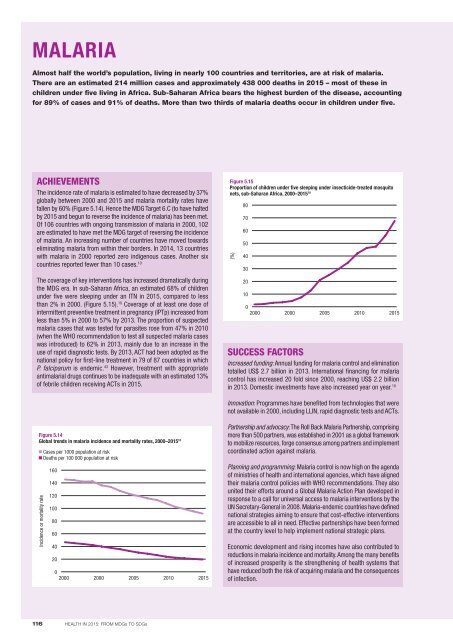You also want an ePaper? Increase the reach of your titles
YUMPU automatically turns print PDFs into web optimized ePapers that Google loves.
MALARIA<br />
Almost half the world’s population, living in nearly 100 countries and terri<strong>to</strong>ries, are at risk of malaria.<br />
There are an estimated 214 million cases and approximately 438 000 deaths in 2015 – most of these in<br />
children under five living in Africa. Sub-Saharan Africa bears the highest burden of the disease, accounting<br />
for 89% of cases and 91% of deaths. More than two thirds of malaria deaths occur in children under five.<br />
ACHIEVEMENTS<br />
The incidence rate of malaria is estimated <strong>to</strong> have decreased by 37%<br />
globally between 2000 and 2015 and malaria mortality rates have<br />
fallen by 60% (Figure 5.14). Hence the MDG Target 6.C (<strong>to</strong> have halted<br />
by 2015 and begun <strong>to</strong> reverse the incidence of malaria) has been met.<br />
Of 106 countries with ongoing transmission of malaria in 2000, 102<br />
are estimated <strong>to</strong> have met the MDG target of reversing the incidence<br />
of malaria. An increasing number of countries have moved <strong>to</strong>wards<br />
eliminating malaria <strong>from</strong> within their borders. In 2014, 13 countries<br />
with malaria in 2000 reported zero indigenous cases. Another six<br />
countries reported fewer than 10 cases. 10<br />
The coverage of key interventions has increased dramatically during<br />
the MDG era. In sub-Saharan Africa, an estimated 68% of children<br />
under five were sleeping under an ITN in 2015, compared <strong>to</strong> less<br />
than 2% in 2000. (Figure 5.15). 10 Coverage of at least one dose of<br />
intermittent preventive treatment in pregnancy (IPTp) increased <strong>from</strong><br />
less than 5% in 2000 <strong>to</strong> 57% by 2013. The proportion of suspected<br />
malaria cases that was tested for parasites rose <strong>from</strong> 47% in 2010<br />
(when the WHO recommendation <strong>to</strong> test all suspected malaria cases<br />
was introduced) <strong>to</strong> 62% in 2013, mainly due <strong>to</strong> an increase in the<br />
use of rapid diagnostic tests. By 2013, ACT had been adopted as the<br />
national policy for first-line treatment in 79 of 87 countries in which<br />
P. falciparum is endemic. 43 However, treatment with appropriate<br />
antimalarial drugs continues <strong>to</strong> be inadequate with an estimated 13%<br />
of febrile children receiving ACTs in 2015.<br />
Figure 5.15<br />
Proportion of children under five sleeping under insecticide-treated mosqui<strong>to</strong><br />
nets, sub-Saharan Africa, 2000–2015 10<br />
(%)<br />
80<br />
70<br />
60<br />
50<br />
40<br />
30<br />
20<br />
10<br />
0<br />
2000 2000 2005 2010 2015<br />
SUCCESS FACTORS<br />
Increased funding: Annual funding for malaria control and elimination<br />
<strong>to</strong>talled US$ 2.7 billion in 2013. International financing for malaria<br />
control has increased 20 fold since 2000, reaching US$ 2.2 billion<br />
in 2013. Domestic investments have also increased year on year. 10<br />
Innovation: Programmes have benefited <strong>from</strong> technologies that were<br />
not available in 2000, including LLIN, rapid diagnostic tests and ACTs.<br />
Figure 5.14<br />
Global trends in malaria incidence and mortality rates, 2000–2015 10<br />
Incidence or mortality rate<br />
Cases per 1000 population at risk<br />
Deaths per 100 000 population at risk<br />
160<br />
140<br />
120<br />
100<br />
80<br />
60<br />
40<br />
20<br />
0<br />
2000 2000 2005 2010 2015<br />
Partnership and advocacy: The Roll Back Malaria Partnership, comprising<br />
more than 500 partners, was established in 2001 as a global framework<br />
<strong>to</strong> mobilize resources, forge consensus among partners and implement<br />
coordinated action against malaria.<br />
Planning and programming: Malaria control is now high on the agenda<br />
of ministries of health and international agencies, which have aligned<br />
their malaria control policies with WHO recommendations. They also<br />
united their efforts around a Global Malaria Action Plan developed in<br />
response <strong>to</strong> a call for universal access <strong>to</strong> malaria interventions by the<br />
UN Secretary-General in 2008. Malaria-endemic countries have defined<br />
national strategies aiming <strong>to</strong> ensure that cost-effective interventions<br />
are accessible <strong>to</strong> all in need. Effective partnerships have been formed<br />
at the country level <strong>to</strong> help implement national strategic plans.<br />
Economic development and rising incomes have also contributed <strong>to</strong><br />
reductions in malaria incidence and mortality. Among the many benefits<br />
of increased prosperity is the strengthening of health systems that<br />
have reduced both the risk of acquiring malaria and the consequences<br />
of infection.<br />
116 HEALTH IN 2015: FROM MDGs TO SDGs


